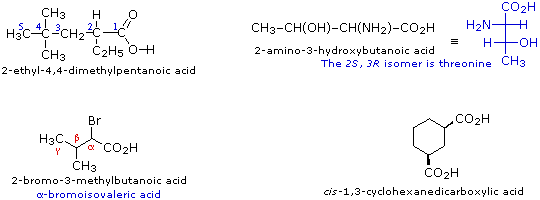
Nomenclature of Carboxylic Acids
 المؤلف:
William Reusch
المؤلف:
William Reusch
 المصدر:
Virtual Textbook of Organic Chemistry
المصدر:
Virtual Textbook of Organic Chemistry
 الجزء والصفحة:
............
الجزء والصفحة:
............
 12-7-2018
12-7-2018
 1495
1495
Nomenclature of Carboxylic Acids
As with aldehydes, the carboxyl group must be located at the end of a carbon chain. In the IUPAC system of nomenclature the carboxyl carbon is designated #1, and other substituents are located and named accordingly. The characteristic IUPAC suffix for a carboxyl group is "oic acid", and care must be taken not to confuse this systematic nomenclature with the similar common system. These two nomenclatures are illustrated in the following table, along with their melting and boiling points.
|
Formula
|
Common Name
|
Source
|
IUPAC Name
|
Melting Point
|
Boiling Point
|
|
HCO2H
|
formic acid
|
ants (L. formica)
|
methanoic acid
|
8.4 ºC
|
101 ºC
|
|
CH3CO2H
|
acetic acid
|
vinegar (L. acetum)
|
ethanoic acid
|
16.6 ºC
|
118 ºC
|
|
CH3CH2CO2H
|
propionic acid
|
milk (Gk. protus prion)
|
propanoic acid
|
-20.8 ºC
|
141 ºC
|
|
CH3(CH2)2CO2H
|
butyric acid
|
butter (L. butyrum)
|
butanoic acid
|
-5.5 ºC
|
164 ºC
|
|
CH3(CH2)3CO2H
|
valeric acid
|
valerian root
|
pentanoic acid
|
-34.5 ºC
|
186 ºC
|
|
CH3(CH2)4CO2H
|
caproic acid
|
goats (L. caper)
|
hexanoic acid
|
-4.0 ºC
|
205 ºC
|
|
CH3(CH2)5CO2H
|
enanthic acid
|
vines (Gk. oenanthe)
|
heptanoic acid
|
-7.5 ºC
|
223 ºC
|
|
CH3(CH2)6CO2H
|
caprylic acid
|
goats (L. caper)
|
octanoic acid
|
16.3 ºC
|
239 ºC
|
|
CH3(CH2)7CO2H
|
pelargonic acid
|
pelargonium (an herb)
|
nonanoic acid
|
12.0 ºC
|
253 ºC
|
|
CH3(CH2)8CO2H
|
capric acid
|
goats (L. caper)
|
decanoic acid
|
31.0 ºC
|
219 ºC
|
Substituted carboxylic acids are named either by the IUPAC system or by common names. If you are uncertain about the IUPAC rules for nomenclature you should review them now. Some common names, the amino acid threonine for example, do not have any systematic origin and must simply be memorized. In other cases, common names make use of the Greek letter notation for carbon atoms near the carboxyl group. Some examples of both nomenclatures are provided below.

Simple dicarboxylic acids having the general formula HO2C–(CH2)n–CO2H (where n = 0 to 5) are known by the common names: Oxalic (n=0), Malonic (n=1), Succinic (n=2), Glutaric (n=3), Adipic (n=4) and Pimelic (n=5) Acids. Common names, such as these can be troublesome to remember, so mnemonic aids, which take the form of a catchy phrase, have been devised. For this group of compounds one such phrase is: "Oh My Such Good Apple Pie".
 الاكثر قراءة في مواضيع عامة في الكيمياء العضوية
الاكثر قراءة في مواضيع عامة في الكيمياء العضوية
 اخر الاخبار
اخر الاخبار
اخبار العتبة العباسية المقدسة


